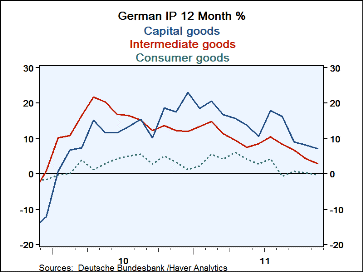 Global| Jan 09 2012
Global| Jan 09 2012Germany Continue to Weaken As Industrial Output Slides
Summary
The profile in the chart of year-over-year growth rates is unmistakable. The trends in the table are clear as well. In terms of growth rates from one year in and shorter, only construction and consumer goods are showing any resilience [...]
 The profile in the chart of year-over-year growth rates is unmistakable. The trends in the table are clear as well.
In terms of growth rates from one year in and shorter, only construction and consumer goods are showing any
resilience and those sectors are not lively enough to swim against the current of marked weakness in other
sectors. Overall MFG IP is off at a 10% annual rate over the most recent three-months and is showing
pronounced deceleration. Its capital goods and intermediate goods sectors underpin that trend. The
trend for industrial orders continues to point the way lower as well.
The profile in the chart of year-over-year growth rates is unmistakable. The trends in the table are clear as well.
In terms of growth rates from one year in and shorter, only construction and consumer goods are showing any
resilience and those sectors are not lively enough to swim against the current of marked weakness in other
sectors. Overall MFG IP is off at a 10% annual rate over the most recent three-months and is showing
pronounced deceleration. Its capital goods and intermediate goods sectors underpin that trend. The
trend for industrial orders continues to point the way lower as well.
In the current quarter the growth rates tell a story of a broad-based decline in output in Q4 compared to Q3. Only the construction sector is escaping the collapse in output.
The one exception to this sour trend is found in the export sector where today’s trade report showed a larger trade surplus as German as exports revived to surge by 2.5% after plunging by 2.9% in October. Yr/Yr Germany exports continue to outpace imports, growing by 8.4% compared to import’s 6.9% advance. But even this is false victory since the export rise did not offset the drop from the month before. Export orders in Germany have become very volatile at year end and the same effect seems to be playing out for exports. The various reports are of one voice on encroaching economic weakness. The PMI indices for Germany have signaled a month of moderation in the ongoing unraveling but that only serves to muddy the waters on how weak things are and about whether conditions will continue to deteriorate at a more rapid pace again next month or not.
The rest of Europe is weak with many countries still fighting for control of their finances, Greece still has not been able to complete its bail out and its debt forgiveness deal In Italy bond yields are surging again. Spain and Portugal are struggling to meet austerity targets even as their economies weaken further. France seem on the verge of losing its AAA rating. And if the Zone cannot come to terms with some compromise, a workable compromise, its fracture will spread more discord and fuel the move to weakness. Thus is the start of 2012.
| Total German IP | |||||||
|---|---|---|---|---|---|---|---|
| SAAR Except M/M | Nov-11 | Oct-11 | Sep-11 | 3Mo | 6Mo | 12Mo | Q-2-D |
| IP total | -0.6% | 0.8% | -2.8% | -10.0% | -1.4% | 3.6% | -7.2% |
| Consumer | -0.7% | -0.1% | 1.4% | 2.4% | -5.8% | -0.3% | -4.6% |
| Capital | -1.0% | 1.7% | -4.6% | -14.8% | -0.3% | 7.2% | -7.4% |
| Intermed | -1.4% | -0.2% | -2.7% | -15.7% | -3.2% | 2.9% | -12.5% |
| Memo | |||||||
| Construction | 4.5% | 1.6% | -1.4% | 20.2% | 6.5% | 10.9% | 11.7% |
| MFG IP | -1.0% | 0.6% | -2.8% | -12.0% | -2.2% | 4.3% | -8.8% |
| Real MFG Orders | -4.8% | 5.0% | 0.0 | -17.0% | -14.2% | -4.3% | -5.2% |
Robert Brusca
AuthorMore in Author Profile »Robert A. Brusca is Chief Economist of Fact and Opinion Economics, a consulting firm he founded in Manhattan. He has been an economist on Wall Street for over 25 years. He has visited central banking and large institutional clients in over 30 countries in his career as an economist. Mr. Brusca was a Divisional Research Chief at the Federal Reserve Bank of NY (Chief of the International Financial markets Division), a Fed Watcher at Irving Trust and Chief Economist at Nikko Securities International. He is widely quoted and appears in various media. Mr. Brusca holds an MA and Ph.D. in economics from Michigan State University and a BA in Economics from the University of Michigan. His research pursues his strong interests in non aligned policy economics as well as international economics. FAO Economics’ research targets investors to assist them in making better investment decisions in stocks, bonds and in a variety of international assets. The company does not manage money and has no conflicts in giving economic advice.






